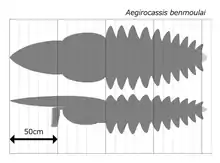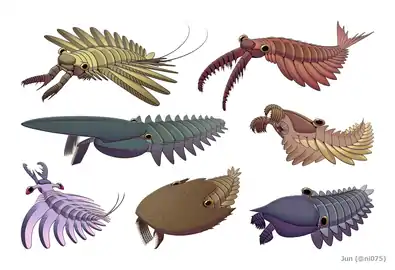Aegirocassis
Aegirocassis is an extinct genus of radiodont arthropod belonging to the family Hurdiidae that lived 480 million years ago during the early Ordovician. It is known by a single species, Aegirocassis benmoulai.[note 1] Van Roy initiated scientific study of the fossil,[3] the earliest known of a "giant" filter-feeder discovered to date.[4] Aegirocassis is considered to have evolved from early predatory radiodonts.[5]
| Aegirocassis Temporal range: Late Tremadocian, | |
|---|---|
 | |
| Reconstruction of Aegirocassis benmoulai | |
| Scientific classification | |
| Kingdom: | Animalia |
| Phylum: | Arthropoda |
| Class: | †Dinocaridida |
| Order: | †Radiodonta |
| Family: | †Hurdiidae |
| Genus: | †Aegirocassis |
| Species: | †A. benmoulai |
| Binomial name | |
| †Aegirocassis benmoulai | |
Description

At the time of its existence, A. benmoulai was possibly the largest animal in the world.[6] The length was described as exceeding 2.0 metres (6.6 ft) in the scientific journal Nature.[1]
The fossil was preserved with exceptional three-dimensional detail, unlike most other radiodont fossils, in which the animals are flattened.[7] The quality of three-dimensional preservation has shed light on the nature of radiodont trunk flaps. Each trunk segment of the Aegirocassis benmoulai specimen has both a ventral and a dorsal pair of flaps. Several details seen clearly in the specimen led to a review and reassessment of research of existing specimens and, most importantly, to the conclusion that the ventral pair are homologous with arthropod endopods (limb-like inner branches) and lobopodian limbs (lobopods), and the dorsal pair are homologous with the flaps of gilled lobopodians and exites (gill-like outer branches) of the arthropod biramous limb.[1][8]
Discovery
A fossil of A. benmoulai from the Fezouata biota, Morocco was discovered by and named after Mohamed Ben Moula, a fossil collector who recognized its rare characteristics and brought it to the notice of a professional paleontologist, Peter Van Roy, at the Ghent University in Belgium.[6]
Notes
References
- Van Roy, Peter; Daley, Allison C.; Briggs, Derek E. G. (2015). "Anomalocaridid trunk limb homology revealed by a giant filter-feeder with paired flaps". Nature. 522 (7554): 77–80. doi:10.1038/nature14256. ISSN 0028-0836. PMID 25762145.
- Van Roy, Peter; Briggs, Derek E. G.; Gaines, Robert R. (2015). "The Fezouata fossils of Morocco; an extraordinary record of marine life in the Early Ordovician". Journal of the Geological Society. 172 (5): 2015–017. doi:10.1144/jgs2015-017. hdl:1854/LU-8714212. ISSN 0016-7649.
- "Human-Sized 'Lobsters' Lived on Earth 480 Million Years Ago". Sci-News.com. 12 March 2015. Retrieved 13 March 2015.
- Banoo, Sindya N. (11 March 2015). "Fossil Tells of 520-Million-Year-Old [sic] Creature Like a Giant Lobster". New York Times. Retrieved 12 March 2015.
- Van Roy, Peter (12 March 2015). "Fossils of huge plankton-eating sea creature shine light on early arthropod evolution". The Conversation. Retrieved 16 March 2015.
- Duhaime-Ross, Arielle (March 11, 2015). "This giant lobster ancestor was once the biggest animal on Earth". The Verge. (Includes an account of Ben Moula showing his fossil to Van Roy).
- "Fossil 'lobster' as big as a human". BT.com. 11 March 2015. Retrieved 12 March 2015.
- Perkins, S. (2015-03-11). "Newly discovered sea creature was once the largest animal on Earth". AAAS. Retrieved 2015-03-13.
